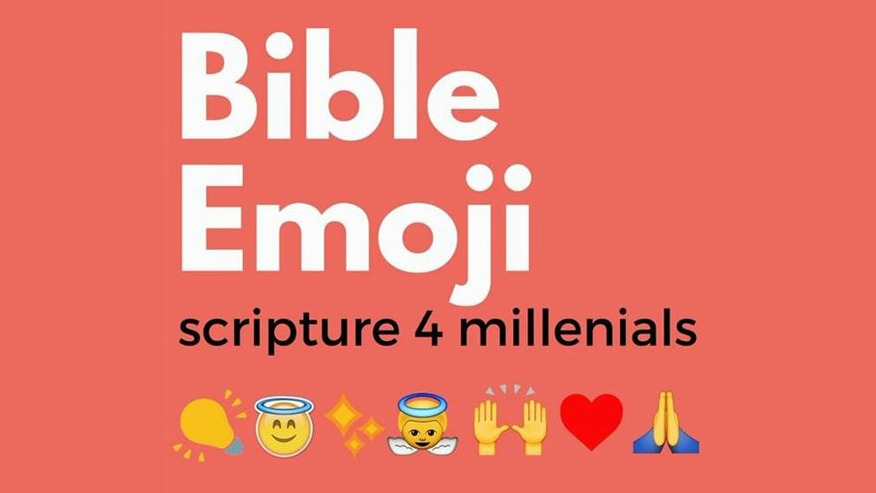Have you heard the Good News? 🙂
Sites from The New York Times to The Washington Post to Forbes are reacting to a new emoji-studded Bible translation—the latest effort to make the Holy Book appeal to young readers.
“Bible Emoji: Scripture 4 Millenials (sic)”—now available for $2.99 on Apple’s iBooks—comes from the Twitter account @BibleEmoji, which replaces select words in Bible verses with corresponding smiley faces or other small icons used in text messages and on social media.
This version follows other lighthearted 21st-century translations such as the LOLCat Bible and the Lego Brick Bible. But for all the hype over this particular digital-era adaptation, the emoji Bible actually doesn’t contain that many emojis. It’s a King James Version (KJV) with 10 to 15 percent of the text swapped for emojis; about one or two symbols appear in each verse.
(The KJV is the most-read version of the Bible by far, and despite the popularity of the NIV for new purchases of the Bible, remains the most-searched version online. It’s also in the public domain in the United States, so changes can be made without seeking permission or paying a fee.)
This distinctly 21st-century twist on the Bible brings up the age-old issue with Bible translation: Should translators stick to an “essentially literal,” word-for-word translation, or should they aim for “dynamic equivalence,” or thought-for-thought?
The emoji Bible goes with the former. A translator program substituted 80 icons that directly represent 200 different words in the text: a tree for a tree, water droplets for rain, and a smiley face emoji with a halo for God. It is also written in all lowercase and makes some “text-friendly substitutions,” like changing “and” to “&.”

The replacement isn’t always smooth. For example, “strangers” ends up with an anger emoji in the middle of the word.

“I think it can be fun for those who know Scripture well, to sort of have a game reading it,” said the anonymous creator, who goes by the smiley face emoji wearing sunglasses. He said he chose the format, which resembles pictures dropped in the middle of KJV verses, because it retained the readability of the text.
“The ‘emoji’ Bible looks like my four-year-old's learn-to-read books,” tweeted Benjamin Reynolds, New Testament professor at Tyndale University College and Seminary. “It's just missing Diego and Thomas the Train.”
The emoji Bible’s literal translation doesn’t reflect the non-literal ways users often employ the icons. For example, thanks to music producer DJ Khaled, the popular key emoji represents advice, tips, or “keys to success.” The “100” emoji isn’t just a number; it represents authenticity and keeping it real.
“The book doesn’t take enough liberties. It gets boring and repetitious,” wrote Jana Reiss, blogger and author of Twible, which summarizes each chapter of the Bible in 140 characters or less. “I’d rather see an emoji Bible that really takes the time to explain the text and lets readers have some fun understanding it.”
Still, any emojis in the Bible—even direct and literal substitution—take away from God’s Word and words, according to some critics.
“Ah… Dear Millennials, please insist on using WORDS to translate the Bible, not emoji. Please. It’s important,” tweeted Al Mohler, president of the Southern Baptist Theological Seminary.
This isn’t the first time yellow smiley faces have met biblical text. This quiz shows examples of Bible stories told through just emojis, and a low-profile Kickstarter project from 2014 sought to create 5,000 new emojis specifically to use in an all-emoji Bible. Especially in the past year, emojis have become a huge cultural force, with billions of the tiny icons texted and tweeted across the globe. The “face with tears of joy” emoji was declared 2015’s word of the year.
This iconic shorthand also gets incorporated into Christian expression. Emoji appear in about 3 percent of Bible verse tweets without images and about 13 percent of Bible verses tweets with images, according to analysis of the “emojipocalypse” by Stephen Smith at OpenBible.info. Popular emojis accompanying Bible verses—often as reaction, rather than transliteration—include prayer hands (No. 1), praise hands (No. 3), hearts, an open book, a pointed finger, an angel, and fire.
These religious-themed options actually rank among the most-misconstrued emojis, according to computer science researchers at the University of Minnesota. NPR reported on their findings, indicating that praise hands rank No. 2 on the list of most-confusing emoji, and prayer hands rank No. 6. (One reason is that the emojis look different on various platforms; what looks like two hands pressed together on Apple devices turns up as a grey—almost alien-looking–figure on Microsoft.)
Created in largely secular Japan, where Christians make up just 1 percent of the population, these emojis didn’t originally connote the religious meaning they do to many Americans now. Alternate meanings for what we see as prayer hands include “please” and “thank you” (a sign of respect in Japanese culture), as well as high-fiving. The “person raising both hands” emoji—often used as shorthand for “praise the Lord”—also represents magic and Festivus miracles, according to Emojipedia.
An additional number of religious-themed emojis debuted last year. Many of them were symbols of other faiths (a synagogue, a menorah, a mosque, and a Shinto shrine, for example), but Christian additions included a cross, a dove, and a symbol for a house of worship.
The new editions have yet to become popular enough to rank in Smith’s running count of trending Christian emojis.
Back in 2013, Her.meneutics discussed how emojis affect the Christian call as stewards of language. Last year, CT put its first emoji on the cover of the magazine, representing shame.











